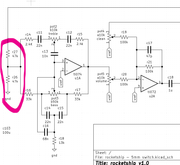thunderaxe
Member
hi all,
i'm working on my first unique(ish) design -- it's an adaptation of the keeley rotten apple (pedalPCB sour grape), which is itself an adaptation of the EHX op amp big muff (pedalPCB dream fuzz). the input, sallen-key and clipping sections are largely the same, then i've added a tone section based on the neve 1073, a clean blend, and as a bonus i used the clean blend path as an optional buffered bypass. it works and sounds good on the breadboard but can you give it a once-over and let me know if i've made any mistakes or if you have any suggestions for how i could do this better or smarter?
just to preempt questions about this: having the clean level control after the distortion volume is deliberate. from a usage standpoint i would've preferred it to be before the volume but doing it this way prevents me from having to boost the clean signal ~22x and clipping the op amp to get it to a level where it can compete with the distorted signal.
any and all advice is appreciated.
thank you!
i'm working on my first unique(ish) design -- it's an adaptation of the keeley rotten apple (pedalPCB sour grape), which is itself an adaptation of the EHX op amp big muff (pedalPCB dream fuzz). the input, sallen-key and clipping sections are largely the same, then i've added a tone section based on the neve 1073, a clean blend, and as a bonus i used the clean blend path as an optional buffered bypass. it works and sounds good on the breadboard but can you give it a once-over and let me know if i've made any mistakes or if you have any suggestions for how i could do this better or smarter?
just to preempt questions about this: having the clean level control after the distortion volume is deliberate. from a usage standpoint i would've preferred it to be before the volume but doing it this way prevents me from having to boost the clean signal ~22x and clipping the op amp to get it to a level where it can compete with the distorted signal.
any and all advice is appreciated.
thank you!
Attachments
Last edited:



